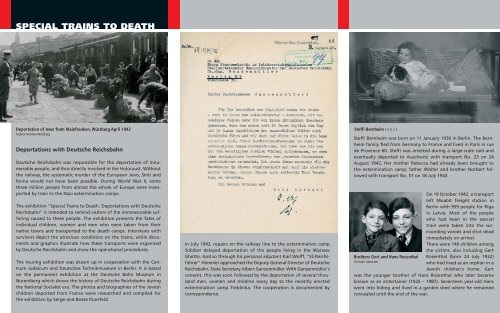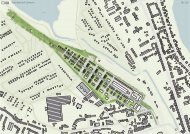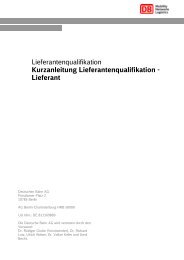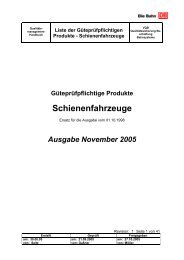Bahn Flyer engl. - Deutsche Bahn AG
Bahn Flyer engl. - Deutsche Bahn AG
Bahn Flyer engl. - Deutsche Bahn AG
Create successful ePaper yourself
Turn your PDF publications into a flip-book with our unique Google optimized e-Paper software.
SPECIAL TRAINS TO DEATH<br />
Deportation of Jews from Mainfranken, Würzburg April 1942<br />
Federal Archives Würzburg<br />
Deportations with <strong>Deutsche</strong> Reichsbahn<br />
<strong>Deutsche</strong> Reichsbahn was responsible for the deportation of innumerable<br />
people, and thus directly involved in the Holocaust. Without<br />
the railway, the systematic murder of the European Jews, Sinti and<br />
Roma would not have been possible. During World War II, some<br />
three million people from almost the whole of Europe were transported<br />
by train to the Nazi extermination camps.<br />
The exhibition "Special Trains to Death. Deportations with <strong>Deutsche</strong><br />
Reichsbahn" is intended to remind visitors of the immeasurable suffering<br />
caused to these people. The exhibition presents the fates of<br />
individual children, women and men who were taken from their<br />
native towns and transported to the death camps. Interviews with<br />
survivors depict the atrocious conditions on the trains, while documents<br />
and graphics illustrate how these transports were organised<br />
by <strong>Deutsche</strong> Reichsbahn and show the operational procedures.<br />
The touring exhibition was drawn up in cooperation with the Centrum<br />
Judaicum and <strong>Deutsche</strong>s Technikmuseum in Berlin. It is based<br />
on the permanent exhibition at the <strong>Deutsche</strong> <strong>Bahn</strong> Museum in<br />
Nuremberg which shows the history of <strong>Deutsche</strong> Reichsbahn during<br />
the National Socialist era. The photos and biographies of the Jewish<br />
children deported from France were researched and compiled for<br />
the exhibition by Serge and Beate Klarsfeld.<br />
In July 1942, repairs on the railway line to the extermination camp<br />
Sobibor delayed deportation of the people living in the Warsaw<br />
Ghetto. And so through his personal adjutant Karl Wolff, "SS Reichsführer"<br />
Himmler approached the Deputy General Director of <strong>Deutsche</strong><br />
Reichsbahn, State Secretary Albert Ganzenmüller. With Ganzenmüller's<br />
consent, this was soon followed by the deportation of several thousand<br />
men, women and children every day to the recently erected<br />
extermination camp Treblinka. The cooperation is documented by<br />
correspondence.<br />
Steffi Bernheim F. F. D. J. F.<br />
Steffi Bernheim was born on 11 January 1930 in Berlin. The Bernheim<br />
family fled from Germany to France and lived in Paris in rue<br />
de Provence 60. Steffi was arrested during a large-scale raid and<br />
eventually deported to Auschwitz with transport No. 23 on 24<br />
August 1942. Her mother Rebecca had already been brought to<br />
the extermination camp; father Walter and brother Norbert followed<br />
with transport No. 57 on 18 July 1943.<br />
Brothers Gert and Hans Rosenthal<br />
Centrum Judaicum<br />
On 19 October 1942, a transport<br />
left Moabit freight station in<br />
Berlin with 959 people for Riga<br />
in Latvia. Most of the people<br />
who had been in the special<br />
train were taken into the surrounding<br />
woods and shot dead<br />
immediately on arrival.<br />
There were 140 children among<br />
the victims, also including Gert<br />
Rosenthal (born 24 July 1932)<br />
who had lived as an orphan in a<br />
Jewish children's home. Gert<br />
was the younger brother of Hans Rosenthal who later became<br />
known as an entertainer (1925 – 1987). Seventeen year-old Hans<br />
went into hiding and lived in a garden shed where he remained<br />
concealed until the end of the war.

















